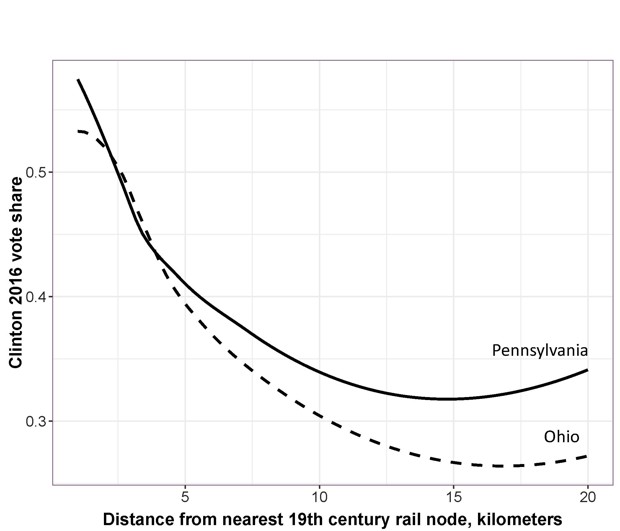When considering some of
the largest causes for divides within the United States’ electorate today, many
would look towards race, education, age, and sex. However, one cleavage remains
seldom discussed yet may be the most important in correlating to
increased polarization between America’s two parties. The factor of rural
versus urban electorates has remained a strong sorting mechanism between the
two parties throughout the last century and has only increased in recent years.
Though not much can be done to stop this attributing factor of party polarization,
its effects will continue to have significant consequences for the American electorate
in the coming decades.
The
rural and urban divide in the United States was quite insignificant back at the
time of its inception. Thomas
Jefferson was well-known for his disdain of city life back in 1803 when he wrote
that cities were evil, dirty and possibly monarchist compared to the virtue and
wisdom inherent to an agrarian lifestyle. This penchant for pastoralism was undoubtedly
quite popular during a period when 94 percent of the US population was located in rural areas.
However, by 1920 a majority of the US population for the first time was considered as living in
urban areas, causing discourse to change with examples like journalists
describing Republican President Warren G. Harding giving speeches to “small
town yokels … low political serfs.” (Grier 2018). Rural and urban divides have
only increased in today’s political climate and have exacerbated unequal
representation within the national government due to using a system that
attempts to balance rural and urban interests even at the cost of “penalizing the
party with the more concentrated base of support.”
It is
well known in contemporary politics that “urban areas tend to vote Democratic,
while suburban and rural areas often lean Republican” and is known as the geographic
constituency for a member of Congress (Adler, Jenkins, and Shipan pg. 82 2019).
These geographic constituencies may go back centuries, as seen in Figure 1
below, which shows the correlation between the distance of old railroad junctions
during industrialization in the 19th Century and Hillary Clinton’s
vote share in the 2016 election. The farther away a voter is from these rail
nodes, the less likely overall they are to have voted for the Democratic presidential
candidate in 2016.
This correlation also has large impacts on which
candidates are chosen in these districts as well as their representation. Due to
Democrats living in ultra-homogenous politically affiliated districts compared to less solid but more
numerous Republican-leaning districts, America’s winner-take-all district system
leads to “the more concentrated party losing out on transforming votes to seats”
(Florida 2019). Another consequence of this is that “Democrats end up winning
substantial majorities in their core districts my margins like 80-20 or 70-30”
while Republicans can win more districts while having less of an edge as a
majority in the district (Florida 2019). These large Democratic vote margins
can encourage more radical candidates, which overall does more harm to the
party platform in the long run within states, as noted by Andrew
B Hall’s “What Happens When Extremists Win Primaries?” The increased
potentiality of creating more extreme candidates of either party “causes severe
damage to the party’s electoral prospects, … makes the party much more likely
to lose the general election today and … makes the opposing party much more
likely to win two to four years later” (Hall 2015).
Solutions to this issue may involve alleviating partisan gerrymandering of districts in an effort to negate the homogeneity of Democratic voters within a state's districts. One such clear example was Pennsylvania in the 2012 general election, as even though "Democratic candidates for Congress won 51% of the votes state-wide [they] came away with majorities in only 28% of the districts." However, even with a computer program that tried to rectify this imbalance of votes to party seats, these "party blind" plans nevertheless still gave Democrats a disadvantage (G.E.M. 2019). Party polarization seems to not be abating anytime soon but author and Stanford
political scientist Jonathon Rodden did note that suburbs are key to becoming
the possible solution to this clear divide. “In the long run, perhaps the
changing populations and greater mixing of the suburbs may help us overcome some
of the extreme polarization that plagues us today” (Florida 2019).
Works
Cited
Adler, Scott, Jeffery A. Jenkins, and Charles R.
Shipan, The United States Congress, (New York, NY: W.W. Norton & Company,
2019), 82.
Brown, Patrick, “Why Democrats Lose,” 31 July 2019,
accessed at https://www.city-journal.org/urban-rural-electoral-divide, 15 Oct
2019.
Florida, Richard, “Why Cities Are Less Powerful in
U.S. National Politics,” 26 Sept 2019, accessed at https://www.citylab.com/life/2019/09/jonathan-rodden-why-cities-lose-book-interview-us-politics/598693/,
15 Oct 2019.
G.E.M., "How America’s urban-rural divide shapes
elections," 3 June 2019, accessed at https://www.economist.com/democracy-in-america/2019/06/03/how-americas-urban-rural-divide-shapes-elections,
15 Oct 2019.
Grier, Peter, “The deep roots of America’s rural-urban
political divide,” 26 Dec 2018, accessed at https://www.csmonitor.com/USA/Politics/2018/1226/The-deep-roots-of-America-s-rural-urban-political-divide,
15 Oct 2019.
Hall, Andrew B., “What Happens When Extremists Win
Elections?” Feb 2015, accessed at https://doi.org/10.1017/S0003055414000641, 15
Oct 2019.

Comments
Post a Comment